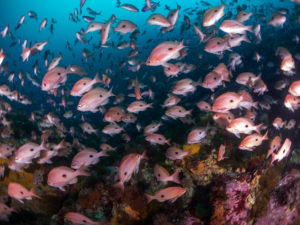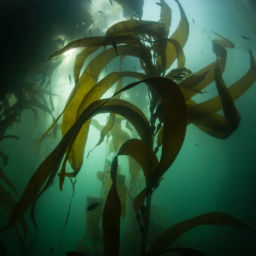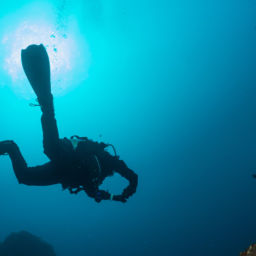It’s off the beaten path
The island of Tasmania sits 150 miles (240 km) south of the Victoria coastline in Australia. Although it is isolated, you can take a ferry from Melbourne to Devenport. Tasmania’s capital city of Hobart is big enough to have museums (MONA, one of the world’s best) and great restaurants, but small enough that you can still discover most of it in a day. Area dive shops are small and most feature a cozy accommodation section and self-contained options. Boats are also smaller, which means that you’ll get a much more personalized experience.
You’ll see huge schools of temperate-water fish
Lots of people associate giant schools of fish exclusively with tropical dive sites, but temperate sites often feature just as many fish. Divers commonly see schools of thousands and thousands of fish off the coast of Tasmania. With crystal-clear water, you can see for over 120 feet (40 m) at times. Butterfly perch are common off the east coast of the island, but they don’t swim in schools. Instead, they hang around a few feet from the bottom in a random nature. They are undisturbed by a diver’s presence and don’t part when you swim toward them, leaving you feeling like one of them.
It’s not really that cold
Tasmania is closer to Antarctica than parts of the Great Barrier Reef, so it will get cold. But the east-coast water temperatures never fall below 54 degrees F (12 C), so you can dive in a 7mm two-piece wetsuit year-round unless you happen to get chilled underwater. During the summer, the water hits a maximum of 66 degrees F (18 C).
You never know what you’ll see
Huge, deep walls covered in soft corals and sponges, with amazing yellow colors, blanket parts of the coastline. Red, green and yellow algae grow together, creating contrasting patterns that will capture your attention. Look for red velvetfish hiding beneath the seaweed, and spot mola molas further off the coast, not far from seal colonies where these playful animals will interact with you underwater. There are also multiple wrecks, some in great condition, spread along the coast.
Who doesn’t love leafy seadragons?
Finally, who wouldn’t love to see a spectacular weedy seadragon? Relatives of the seahorse, the weedy seadragons in Tasmania are some of the biggest individuals of the species. The bright and unusual purple color of the eggs that males carry on their tails make for particularly vibrant photo subjects.








